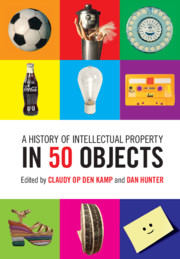Book contents
- Frontmatter
- Dedication
- Contents
- Acknowledgments
- Introduction: Of People, Places, and Parlance
- The Pre-Modern Period
- The Age of invention
- Modern Times
- 18 Player Piano Roll
- 19 Champagne
- 20 Steamboat Willie
- 21 PH-Lamp
- 22 Climbing Rose
- 23 Penguin Paperback
- 24 Ferragamo Wedge
- 25 Aspirin Pill
- The Consumption Age
- The Digital Now
- About The Contributors
21 - PH-Lamp
from Modern Times
Published online by Cambridge University Press: 12 June 2019
- Frontmatter
- Dedication
- Contents
- Acknowledgments
- Introduction: Of People, Places, and Parlance
- The Pre-Modern Period
- The Age of invention
- Modern Times
- 18 Player Piano Roll
- 19 Champagne
- 20 Steamboat Willie
- 21 PH-Lamp
- 22 Climbing Rose
- 23 Penguin Paperback
- 24 Ferragamo Wedge
- 25 Aspirin Pill
- The Consumption Age
- The Digital Now
- About The Contributors
Summary
THE “PH-LAMP” IS a Danish design classic. It comes in different variants— pendant lamps, table lamps, and floor lamps, in different sizes and colors—but all are characterized by a three-shade design that enables glare-free lighting. Since the 1920s, when the manufacturer Louis Poulsen Lighting Aps first marketed the lamp, it has been popular in Denmark and beyond among cultural elites and design connoisseurs alike. It has been awarded design prizes, displayed in museums, used in art projects and—importantly for us—it has been copied endlessly by rivals in the market for designer goods.
The lamp was created by the Danish designer Poul Henningsen (1894—1967) in accordance with Louis H. Sullivan's famous aphorism, “form ever follows function.” In modern Danish design this dictum was turned into a strategy that promoted the ideal of a perfect unity between the aesthetic and the useful. The Danish Modern movement was personified by Henningsen, along with Arne Jacobsen, FinnJuhl, Hans Wegner, Børge Mogensen, Mogens Lassen, Grethe Jalk, and others. Their chairs, tables, sofas, cutlery, lamps, door handles, and more have been widely celebrated for the aesthetic stripped of ornament, allowing, it is said, the sheer beauty of functionality to shine through. The PH-lamp captures in some measure how the concept of “Danish Modern” emerged—a concept created by a savvy mixture of intellectual property law reform, national interest, and marketing.
Since the beginning of the 20th century the indivisibility of form and function has been celebrated as a defining value of Danish design. Yet, in the context of intellectual property law the marriage between the aesthetic and the functional turned out to be complicated. Intellectual property law categorically allocates the aesthetic and the functional to different branches of law: aesthetic considerations are generally covered by design laws or copyright; while the functional has always been the province of patent. As a result, in the first half of the twentieth Century, intellectual property protection of design was erratic.
- Type
- Chapter
- Information
- A History of Intellectual Property in 50 Objects , pp. 176 - 183Publisher: Cambridge University PressPrint publication year: 2019
- 1
- Cited by

